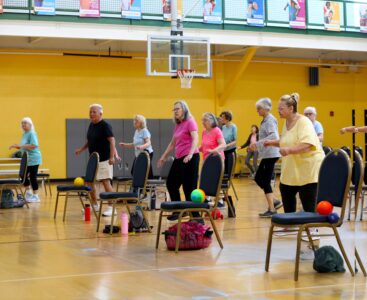Nashua Fire Rescue trains for worst-case scenarios
Firefighter Todd Weeks said he has never been trapped in a burning building.
“Not yet, thankfully,” he said.
Weeks, who serves at the Conant Road firehouse on Engine 6, was one of a handful of Nashua Fire Rescue firefighters who worked at the city’s training grounds last week in the
hands-on portion of a two-part training session designed to reinforce basic self-preservation skills.
“This is my favorite kind of training,” said Weeks, a nine-year veteran of the department. “It’s different than reading the text and having a classroom-type discussion than when you throw that person in that situation where they’re trapped in a small bathroom … OK, now get them out. It can be quite difficult.”
All of the department’s firefighters, all the way up to the deputy chief rank, will complete the two-month process, which is based on studies of firefighter fatalities across the country.
The efforts were initiated by the International Association of Fire Fighters.
A study was shown that repeated mistakes and failure to follow basic procedures were common in the fatalities, according to Bill Campbell, training safety lieutenant for Nashua Fire Rescue.
The practical portion follows an eight-hour online component.
Once that certificate has been earned, they tackle the physical component. It will take about two months for all of the city firefighters to go through the training.
Three specially designed props are set up at the training grounds off West Hollis Street, each one simulating different scenarios a firefighter may experience in a house fire. The simulations force the firefighters to remember basic safety practices and prompt quick thinking – “muscle memory,” Campbell said.
One exercise allows them to practice exiting a window in an emergency. Another is a short tunnel filled with a tangle of wire designed to snare a firefighter and the gear they wear.
A third prop features a simulated wall that they must break through. The dimensions of the resulting hole are the same as the space between the studs in a home’s wall. The firefighters must get themselves and their air packs through the tight spaces, one square and one a vertical rectangle.
Campbell said the practical portion is about “putting yourself into a position to say, ‘Hey, something went wrong, what are you going to do?’
“These are all skills the New Hampshire Fire Service is really good about getting out there initially.”
But as careers advance, other demands, such as hazardous materials and EMT skills requirements, get more focus.
“When the panic situation happens, they’re not thinking,” Campbell said. “These skills become automatic.
“It’s a mindset change, it’s a culture change. It’s to get guys to think about, ‘What am I going to do if something goes wrong?’ If you don’t plan for it, you don’t know how you’re going to react to it.”
After doing his share of “wall breaches,” Weeks said, “I think this is the best kind of training possible, because it’s something that we don’t get to do that often. You have that high risk/low frequency situation that’s not common.
“Getting trapped in something like that isn’t going to be commonplace. But if it does happen, like everything else, you need to rely on your past experiences to get out of it.”
To illustrate the importance of this type of training, Weeks recalled a fire he was in as a probationary firefighter new to the job.
“I was advancing a hose line,” he said. Part of a ceiling gave way and fell on him. At that moment, he was by himself. He said visibility went from moderate to zero.
Weeks said in training, he learned to follow the hose up, where he found the other firefighter he was supposed to be working with.
“I wasn’t thinking about it,” he said. “It was something drilled into you to the point where you weren’t thinking about it and your actions just take over.”
He admits the intensity a fire scene can create.
“It’s scary in there,” he said. “Anyone who tells you different is trying to man up too much.”
The state’s fire academy provided the special props, and Home Depot donated sheets of drywall.
Campbell said the department plans to build its own similar devices and have them part of regular training moving forward.
Don Himsel can be reached at 594-6590 or dhimsel@nashuatelegraph.com. Also, follow Himsel on Twitter (@Telegraph_DonH).


